How Much Electricity Does a Computer Use?
When it comes to electricity consumption, computers play a significant role in our daily lives. Whether you use a laptop for work or enjoy gaming on a powerful desktop, understanding how much electricity your computer consumes can help you make informed decisions about energy efficiency and cost savings.
So, let’s dive into the world of computer usage and explore the factors that determine electricity consumption, as well as ways to optimize energy efficiency.
Firstly, the amount of electricity a computer uses varies depending on its type and usage. Laptops generally consume between 30 to 70 watts, while larger desktop and gaming computers can gulp down a hefty 200 to 500 watts of power.
As a reference point, using a computer for 8 hours per day will result in approximately 12.2 kilowatt-hours of electricity per month or 146 kilowatt-hours per year. On average, that’s about $1.73 per month and $20.72 per year in electricity costs.
An important factor to consider is the power supply unit (PSU). Different PSUs have varying energy efficiency ratings, so investing in an energy-efficient computer can lead to significant savings in the long run.
Moreover, for those looking to reduce their environmental impact, solar panels can also be a viable option to power computers and minimize electricity usage from the grid.
With a clear understanding of computer electricity consumption, we can now explore the factors that affect it and learn how to calculate and optimize energy usage. Let’s dive deeper into these aspects in the following sections.
Factors Affecting Computer Electricity Usage
Several factors can impact the electricity usage of a computer. Understanding these factors can help you optimize your computer’s energy efficiency and reduce its environmental impact. Let’s take a closer look at each one:
1. Computer Hardware
The type of computer hardware you have, particularly the power supply unit (PSU), plays a significant role in determining how much electricity your computer consumes. Higher wattage PSUs tend to consume more power, especially when running demanding tasks or components.
Choosing an energy-efficient PSU can be a wise investment. Look for PSUs that are certified by organizations like ENERGY STAR® or carry high 80 PLUS® efficiency ratings. These PSUs convert more of the electrical input into usable power, resulting in less waste and lower electricity bills.
2. Electrical Circuit
The electrical circuit your computer is connected to can also impact its electricity consumption. The voltage and amperage of the circuit affect how much power your computer draws. Ensure that your computer is plugged into a circuit that can handle the power requirements of your setup.
3. Computer Components
The individual components within your computer contribute to its power usage. Processors (CPUs), graphics cards, RAM modules, and storage devices all consume varying amounts of electricity. High-performance components often require more power to operate efficiently.
When building or upgrading your computer, consider choosing components that strike a balance between performance and energy efficiency. Look for components with low power consumption ratings or features specifically designed for power management.
4. Computer Peripherals
Computer peripherals, such as monitors, speakers, printers, and external storage devices, can add to the overall electricity consumption. These peripherals draw power from your computer or separate power sources.
To minimize power usage, consider turning off or disconnecting peripherals when they are not in use. Additionally, look for energy-saving features or power management settings on your peripherals to further optimize their electricity usage.
By understanding these factors and making conscious choices when it comes to computer hardware, electrical circuits, computer components, and peripherals, you can reduce your computer’s electricity usage and contribute to a more sustainable future.
How to Calculate Computer Electricity Usage
To accurately determine the electricity usage of your computer, you can utilize a kilowatt-hour meter. This device allows you to measure the amount of electricity consumed by your computer setup over a specific period of time. By connecting your computer to the meter, you can track the kilowatt-hours (kWh) used, which is the standard unit of electricity consumption.
Once you have measured the kilowatt-hours, you can estimate the cost of running your computer by multiplying it with the prevailing electricity rate in your area. It’s important to note that electricity rates can vary based on your location and may have different rates for peak and off-peak hours. Consulting your electricity bill or contacting your utility provider will provide you with the necessary information regarding the electricity rate.
By using this simple yet effective method, you can calculate the actual cost of running your computer. This calculation allows you to gain insight into your electricity consumption and make informed decisions to manage your electricity usage.
Example Calculation:
Let’s say your computer setup consumed 50 kilowatt-hours of electricity over a month. The prevailing electricity rate in your area is $0.15 per kilowatt-hour. To estimate the cost, you would multiply 50 kWh by $0.15:
Cost = 50 kWh × $0.15/kWh = $7.50
Therefore, the estimated cost of running your computer for a month would be $7.50.
By calculating your computer’s electricity usage, you can gain a better understanding of its impact on your energy consumption and expense. This knowledge can help you make informed choices, such as adopting energy-efficient practices or adjusting your computer usage habits to optimize electricity consumption and reduce costs.
Tips for Optimizing Computer Electricity Usage
When it comes to reducing the electricity usage of your computer, there are several effective strategies to consider. One of the most impactful steps you can take is to invest in energy-efficient computers. These computers are specifically designed to minimize power consumption without compromising performance, making them a great long-term investment for both your wallet and the environment.
Another key aspect to focus on is activating power-saving features. Enabling sleep mode or hibernation mode when your computer is not in use can significantly reduce electricity usage. Instead of keeping your computer running continuously, these features allow it to enter a low-power state, conserving energy without shutting down completely.
Adjusting your computer usage habits can also make a noticeable difference. Simply turning off your computer when you’re not using it, instead of letting it idle, can contribute to significant energy savings over time. By developing a habit of powering down your computer when it’s not needed, you’ll be making a conscious effort to optimize electricity usage.
Furthermore, exploring the power management settings within the operating system of your computer can help regulate and reduce power consumption. These settings allow you to customize various aspects such as screen brightness, processor performance, and standby timers to further optimize energy efficiency. By fine-tuning these settings according to your preferences and needs, you can maximize the efficiency of your computer’s electricity consumption.






